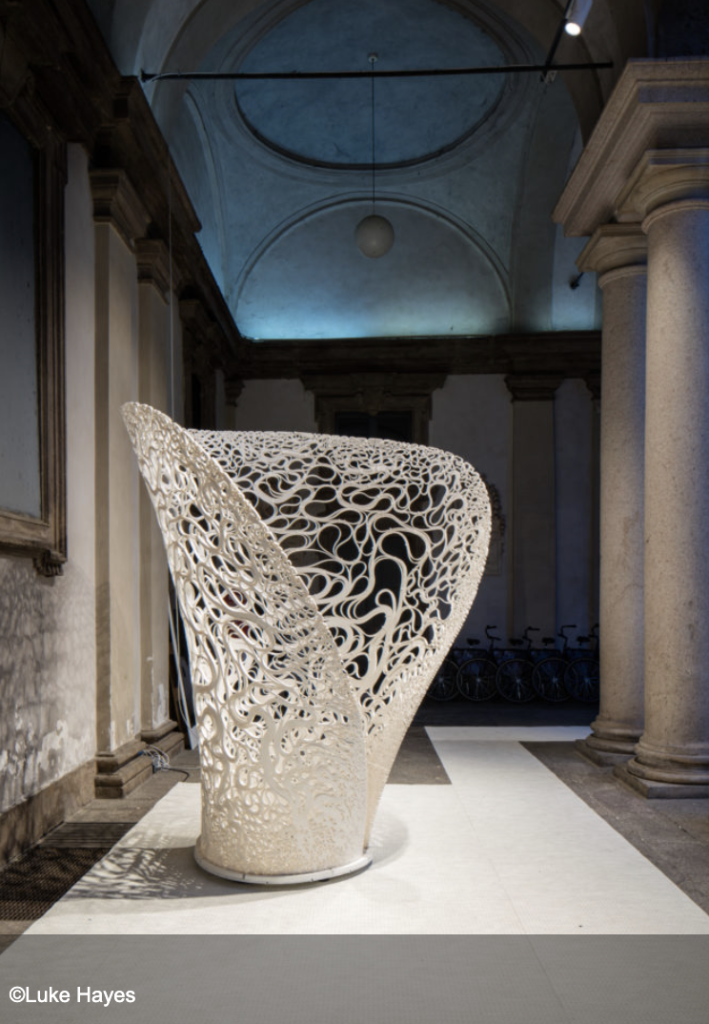Mini assignment #1: Examples of Computational Design
Goal: This mini assignment aims to get you thinking about and recognizing computational design in the world around you. You will look for and record various examples of computational design in nature as well as the human-made environment. Pay special attention to the patterns and types of shapes used as they may serve as inspiration for your own work later in the course.
—
Examples of computational design in nature in each of these three categories: botanical, zoological, and environment-built by non-humans.
—
- Botanical: The Romanesco Cauliflower
The Romanesco cauliflower is a visually stunning vegetable renowned for its remarkable fractal-like design. Its unique appearance is a natural example of a fractal, a complex geometric pattern that repeats itself on different scales. The surface of the Romanesco cauliflower displays a captivating pattern composed of intricate, self-replicating spirals. These spirals form smaller spirals, and each smaller spiral further unfolds into even smaller ones, creating a mesmerizing and seemingly infinite series of smaller buds or “fractals” within the overall structure. This self-replicating pattern continues down to the smallest florets, all maintaining the same spiral-like structure. The fractal design of the Romanesco cauliflower is not only aesthetically appealing but also a beautiful illustration of nature’s inherent mathematical elegance and complexity. It’s a fascinating example of how mathematics and natural beauty intersect in the plant world.
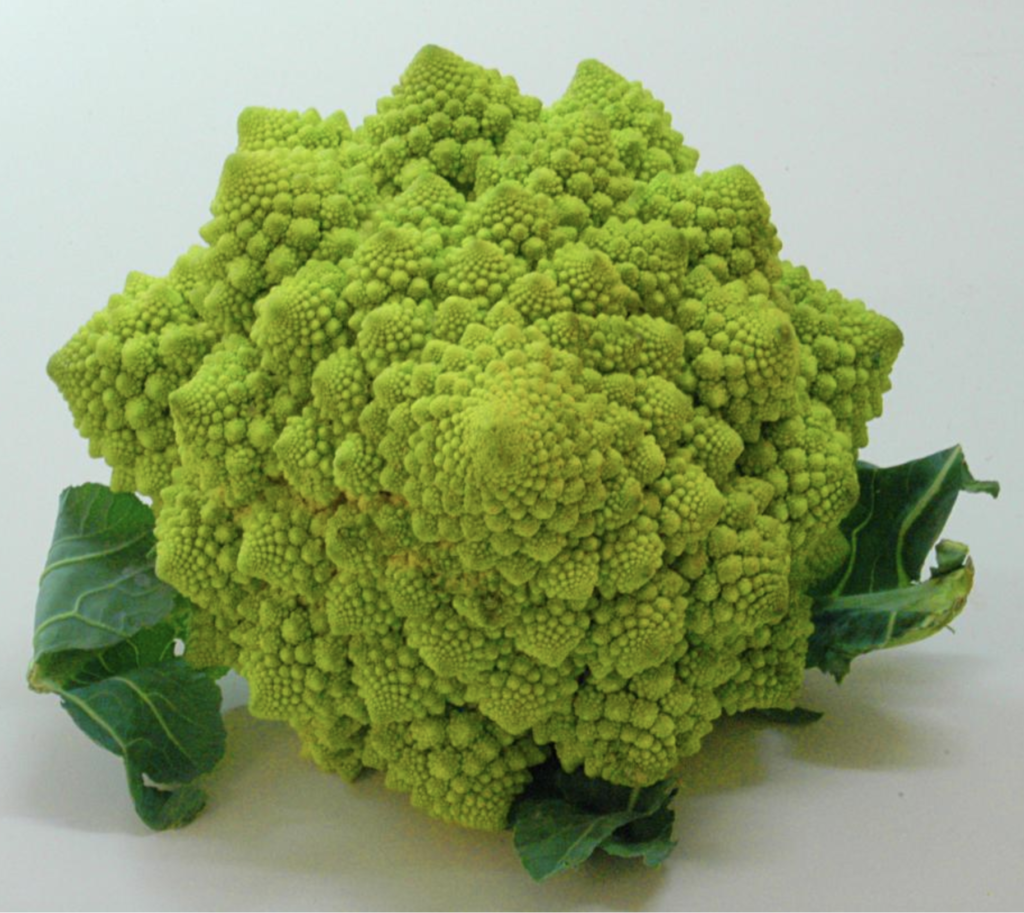
Image: https://www.fourmilab.ch/images/Romanesco/
Source: https://blog.makerlab.com/2008/12/romanesco-cauliflower-my-favorite-fractal-vegetable/
- Zoological: The silica skeleton of the Venus’s flower-basket sea sponge
Venus’s flower basket (Euplectella aspergillum) is a marine animal that lives anchored to the deep ocean floor near the Philippines. Looking more like delicate sculptures than animals, these tube-shaped sea sponges typically stand 10 to 30 cm tall and filter tiny food particles from the seawater as it flows through their bodies. Also known as glass sponges, their cylindrical skeletons are made out of silica, the main component of glass. While glass is normally a brittle and fragile material, Venus’s flower basket’s skeleton is tough and stable owing to its composition and how it’s organized. There are at least six levels of organization in the skeleton that span from nanometers to centimeters in size.

What calls my attention is the structure of this sponge’s skeleton is its similarity to the infill material we see in 3D-printed objects. Observing the glass sponge, it’s possible to envision materials designed with layered internal structures that confer both durability and adaptability. These types of materials could potentially serve as lightweight implants for joint or bone replacements. If implemented in the realm of transportation, such materials might offer a balance of safety and strength while reducing weight and, consequently, fuel usage.
Source: https://asknature.org/strategy/glass-skeleton-is-tough-yet-flexible/
- Non-human built: Bird Nests
Bird nests, from a computational perspective observed in nature, can be viewed as remarkable structures optimized for functionality, efficiency, and adaptability. The construction of a bird’s nest involves an intricate interplay of instinct, environmental factors, and evolutionary processes, reflecting a natural form of computational design. Guided by an instinctual algorithm encoded in their genes, birds carefully select and arrange materials, such as twigs, leaves, and feathers, in a meticulously calculated manner. This process resembles a computational algorithm that optimizes for structural integrity, thermal regulation, and protection from the elements. The birds iteratively refine their design, incorporating past experiences and adjusting the nest’s structure based on environmental conditions. This iterative process mirrors the principles of an evolutionary algorithm, resulting in nests that exemplify a balance of efficiency, adaptability, and resource utilization. The final nest stands as a testament to the beauty and effectiveness of computational design manifesting in the natural creations of non-human entities.
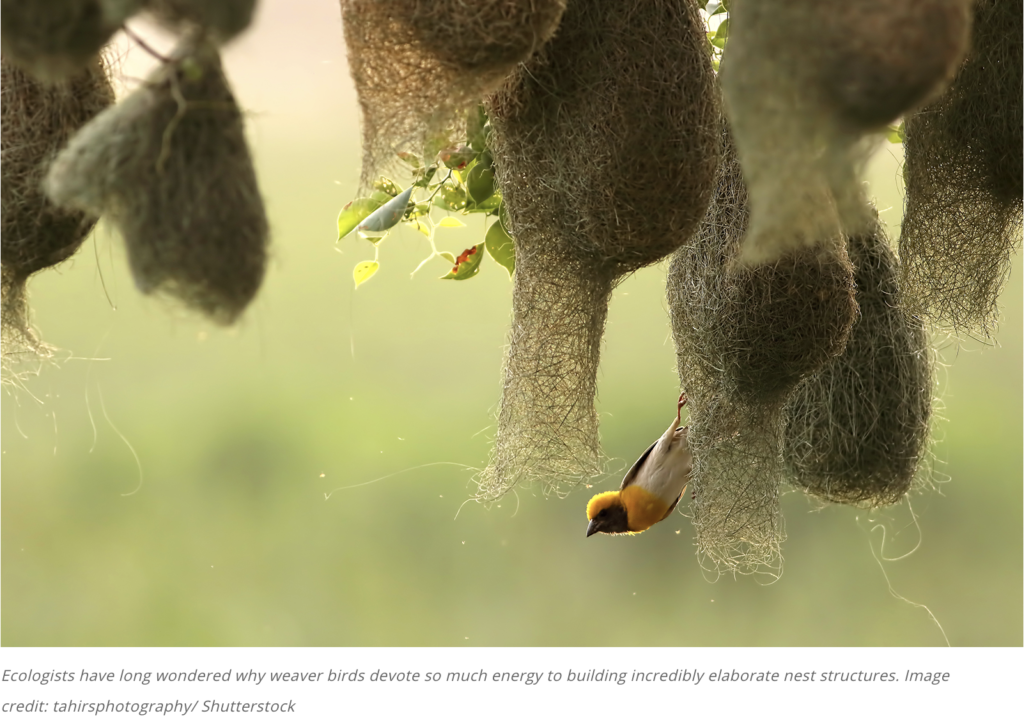
Sources: https://www.popularmechanics.com/science/a31707926/birds-science-nerds/ https://phys.org/news/2022-12-birds-hanging-nests-offspring-invaders.html https://www.nytimes.com/2020/03/17/science/why-birds-are-the-worlds-best-engineers.html
—
Three examples of computational design in the human-made built environment: i.e. architecture, pottery, and textiles.
- Architecture: Beijing National Stadium Facade – Bird’s Nest
The Beijing National Stadium, also known as the Bird’s Nest, is an iconic architectural marvel characterized by its revolutionary computational design. Inspired by Chinese ceramics and the concept of interwoven branches, the stadium’s design leverages advanced computational algorithms to create a complex lattice-like structure. The intricate arrangement of steel beams and nodes was optimized using computational simulations to achieve both structural stability and aesthetic appeal. This design approach allowed for precise calculation of load distribution and material efficiency, resulting in an awe-inspiring, visually striking stadium that perfectly embodies the fusion of art, engineering, and computational innovation.
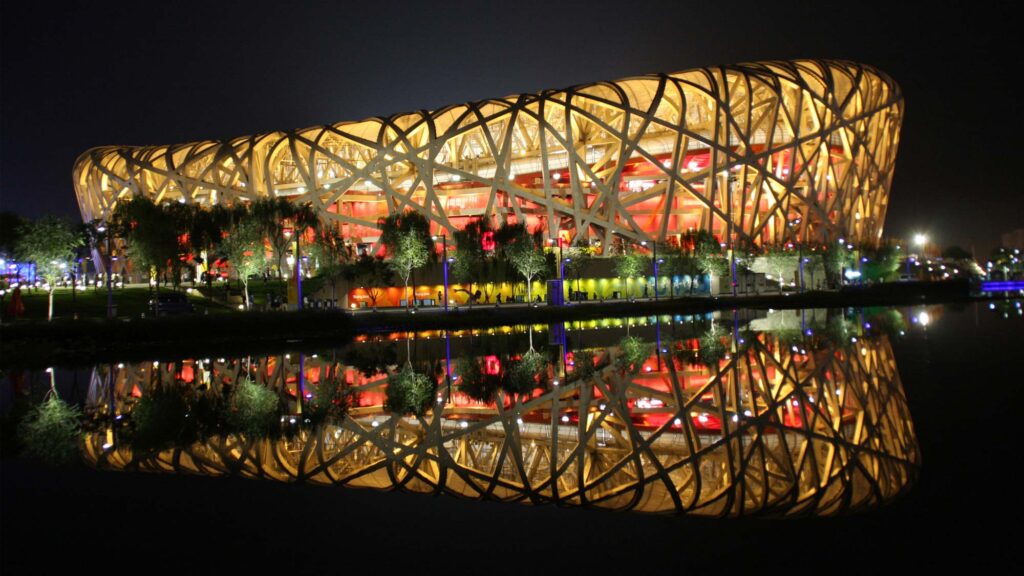
Image: https://www.arup.com/projects/chinese-national-stadium
Source: https://www.iaacblog.com/programs/beijing-national-stadium-birds-nest/
- Tessellation Quilt Pattern in Textiles
Tessellation is the mathematical term for a pattern where an area is covered with tiles that do not overlap and leave no gaps. Artists have employed tessellations for millennia. Examples can be seen in ancient Roman mosaics, the intricate tilework of Suleiman’s Topkapi palace in Istanbul, and the tessellated designs adorning historic stained glass windows in churches. A notable modern artist renowned for his tessellation artwork was M.C. Escher (1898 – 1972). In textiles, that hasn’t been an exception and is used for quilting. Quilters frequently incorporate tessellations into their designs, often without explicit awareness. It’s highly probable that the geometric quilt crafted by your great-grandmother over a century ago features a tessellated design. In fact, fundamental quilt patterns like the “nine-patch” or the “lone star” are recognized as tessellations.
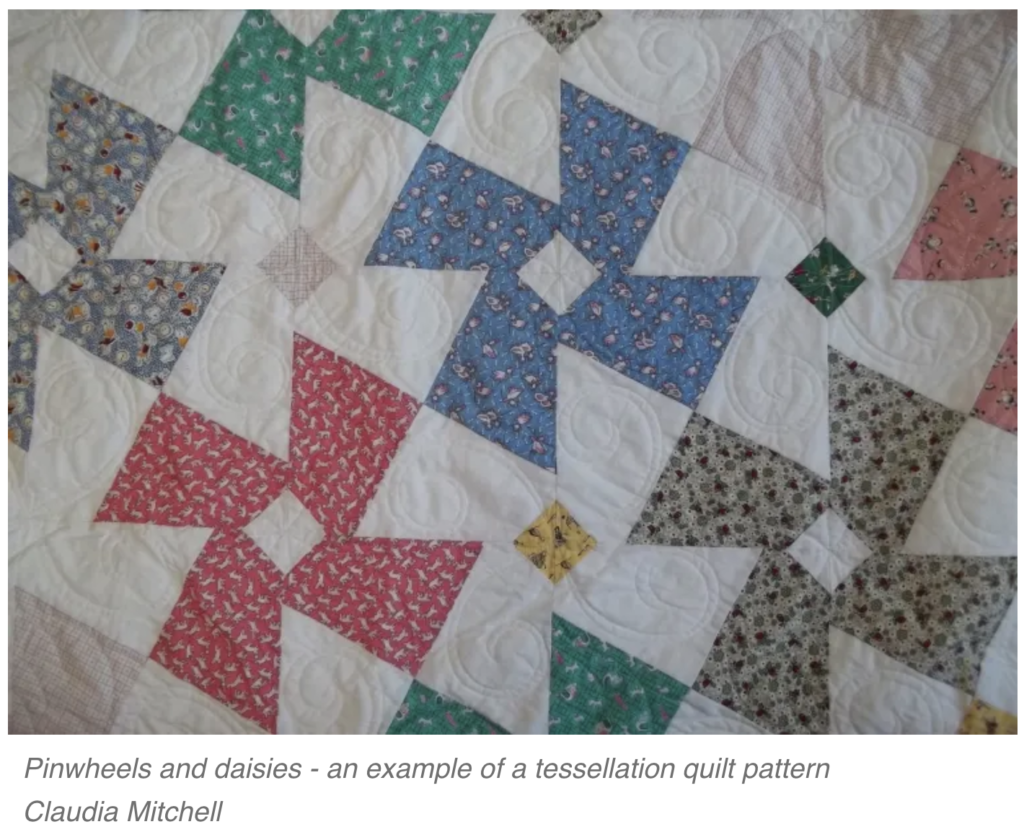
Source: https://feltmagnet.com/textiles-sewing/How-to-Design-Tessellated-Quilt-Patterns
- Soccer balls!
A soccer ball (or football) is a great example of a structure with a computational pattern. The most common type of soccer ball, known as a truncated icosahedron, is composed of regular polygons—specifically, 20 hexagons and 12 pentagons. This arrangement is a highly symmetrical and efficient tessellation pattern. The hexagons and pentagons are arranged in a way that each vertex (corner) is shared by three edges, providing optimal surface coverage while maintaining the structural integrity of the ball. This pattern is carefully designed to create a spherical shape and maintain a consistent weight distribution, making the ball suitable for play in the sport. The computational precision and balance in the arrangement of these polygons contribute to the ball’s aerodynamic properties and behavior on the field.
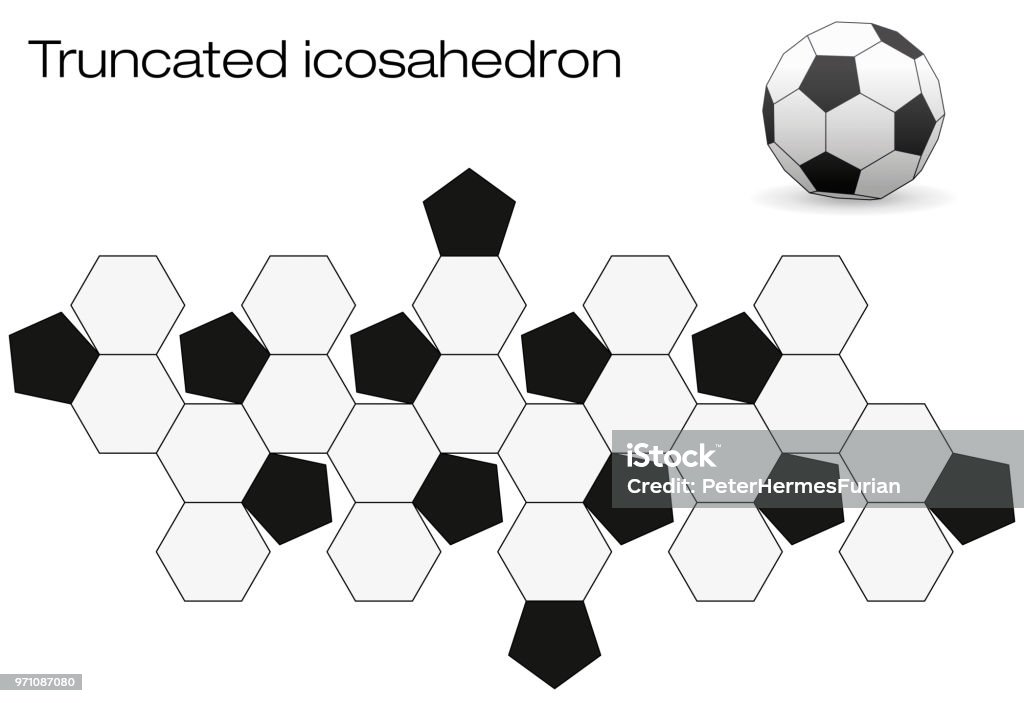
Source: https://en.wikipedia.org/wiki/Truncated_icosahedron --- Find two researchers/artists/designers of computational fabrication. ---
- Studio RAP: 3D Printed Ceramic Vases
URL: https://studiorap.nl/3D-Ceramic-Printed-Vases
Description: By combining modern ceramic 3D printing, computer-based design, and skilled glazing, this project showcases how ceramics and decorative elements can be used in contemporary architecture. The design is inspired by the innovative New Delfts Blue Poortmeesters project, resulting in unique vases with a quirky touch.
Personal Thoughts: I’m impressed by how the algorithm they developed had such a hands-on impact on the design, guiding the robotic production to give each vase its own special features. It’s amazing to see computational design and digital crafting come to life in this small-scale project and we don’t see just repetition.

- Zaha Hadid Architects: Thallus Installation
URL: https://www.zaha-hadid.com/design/thallus-installation/
Description: Thallus is an experimental installation that was computationally designed. It embodies fluidity and organic forms, reminiscent of natural structures like tree roots or coral formations. The installation seamlessly combines art, architecture, and technology, creating an immersive experience that challenges traditional spatial boundaries and showcases Hadid’s innovative design language.
Personal Thoughts: I find this project interesting because computational fabrication is not only present in the nature-inspired design but the use of computational tools that enable the architects and designers to simulate and analyze the performance of the structure before fabrication.
